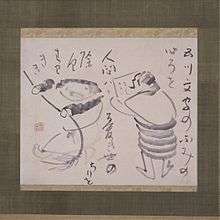Sengai

Sengai Gibon (仙厓 義梵, 1750 - 1837) was a Japanese monk of the Rinzai (臨在宗) school (one of three main schools of Zen Buddhism in Japan, the others being the Soto school and the much smaller Obaku school.). He was known for his controversial teachings and writings, as well as for his lighthearted sumi-e paintings. After spending half of his life in Nagata near Yokohama, he secluded himself in Shōfukuji (in Fukuoka), the first Zen temple in Japan, where he spent the rest of his life.
Though the Rinzai sect is particularly known for its hard-to-understand teachings, Sengai tried to make them accessible to the public.
One of his famous paintings shows a circle, a square and a triangle. Sengai left the painting without a title or inscription (save for his signature); the painting is often called "The Universe" when referred to in English.
"My play with brush and ink is not calligraphy nor painting; yet unknowing people mistakenly think: this is calligraphy, this is painting." — Sengai Gibon
See also
External links
- Idemitsu Museum introduction (Japanese)
- Kyushu University collection of images (Japanese)
- Review of the exhibition at the Idemitsu Museum